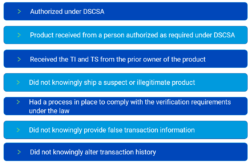MYONEX INSIGHTS
Protecting Patients: The importance of Track & Trace for pharmaceuticals in the US
Posted on 02/10/22People around the world are joining clinical trials every day. As they pick up prescriptions or sit at their trial site waiting for an injection or drug, they may wonder – where did this product come from?
Falsified medicines are a major concern not just for clinical trials, but in the pharmaceutical industry. Illegitimate drugs might be distributed to patients without their knowledge.
In the United States, the Drug Supply Chain Security Act (DSCSA) outlines steps to build an electronic, interoperable system to identify and trace certain prescription drugs as they are distributed in the US. The overall goal of the DSCSA is to guarantee safety, quality, and accuracy of all drug products as they travel through the supply chain to reach the consumer.
When drugs are traced through the supply chain, we can reduce the risk of falsified medicines entering the supply chain. Managing the chain of one product can be complex, due to the rise of global supply chains. Traceability plays a major role in our business and in our customers’ needs.
Is Tracking and Tracing the same?
No, Tracking is the monitoring of the movement of a product, whether within a warehouse, on the factory floor, in production stations, in the field, or within the supply chain itself. Tracing has to do with the authentication of a commodity. It involves the identification of the product, its origin, and the origin of its components or inputs. In other words, important information about the product itself and the participants in the chain. (Souza, 2019)
At Myonex, we take responsibility for any prescription pharmaceuticals that come through our doors.
In the US, we use TrackTraceRX software to maintain “T3” information to meet the requirements of DSCSA and provide to our clients. You may be asking – what makes up the T3 or what is a T3? A T3 is the transaction detail and is made up of the following:
- Transaction information (TI)
- Transaction History (TH)
- Transaction Statement (TS)
It is important that we as a company hold up our end to ensure the documentation is complete, correct, and can be easily accessible. The term ‘transaction history’ means a statement in paper or electronic form, including the transaction information for each prior transaction going back to the manufacturer of the product. The required transaction information includes a lot of information from product name and strength to dosage form, container size, and lot number, to just name a few.
The Transaction statement is a statement in paper or electronic form that the entity transferring ownership in a transaction:

At Myonex, our mission is to provide superior clinical trial supply solutions to support innovations in medicine. We focus on our customers and try to provide fast and efficient solutions to the trial and offer ways to reduce costs. By keeping our customers at the forefront of our job, we are playing a small part in the bigger picture. In our line of business, we do not always see the finished product firsthand, however, it’s important for us at Myonex to know that we make a difference every day and that our work may very well help save someone. That is why tracking and tracing drug products is important, and we continue to play our role in the supply chain of the products we buy, store, and deliver.
 Stephen Finore
Stephen Finore
Procurement Associate

